Yunfei Bai
An Explainable Natural Language Framework for Identifying and Notifying Target Audiences In Enterprise Communication
Aug 07, 2025Abstract:In large-scale maintenance organizations, identifying subject matter experts and managing communications across complex entities relationships poses significant challenges -- including information overload and longer response times -- that traditional communication approaches fail to address effectively. We propose a novel framework that combines RDF graph databases with LLMs to process natural language queries for precise audience targeting, while providing transparent reasoning through a planning-orchestration architecture. Our solution enables communication owners to formulate intuitive queries combining concepts such as equipment, manufacturers, maintenance engineers, and facilities, delivering explainable results that maintain trust in the system while improving communication efficiency across the organization.
Deep RL at Scale: Sorting Waste in Office Buildings with a Fleet of Mobile Manipulators
May 05, 2023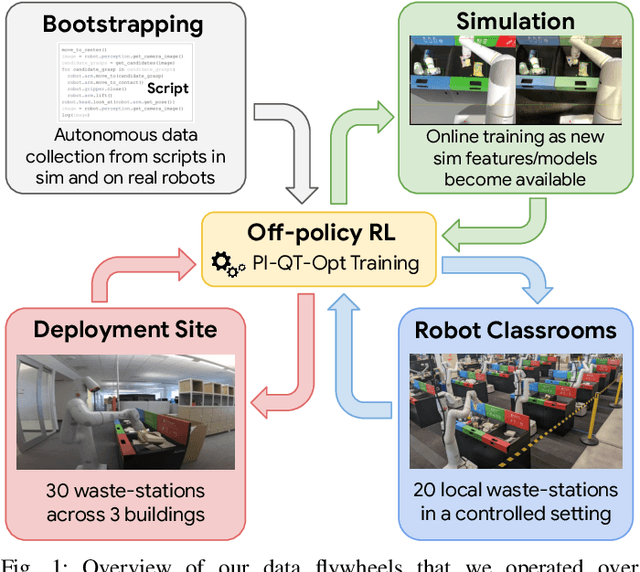
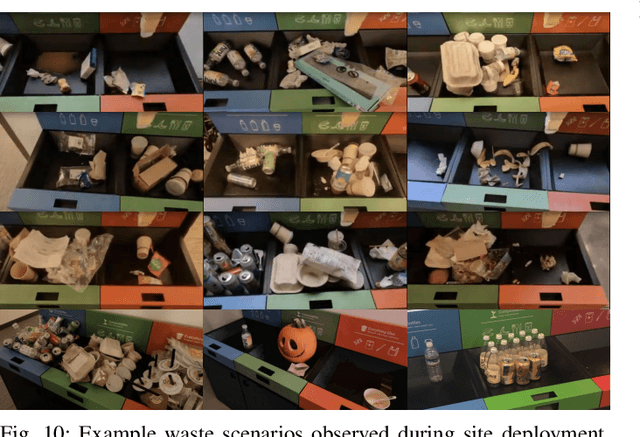
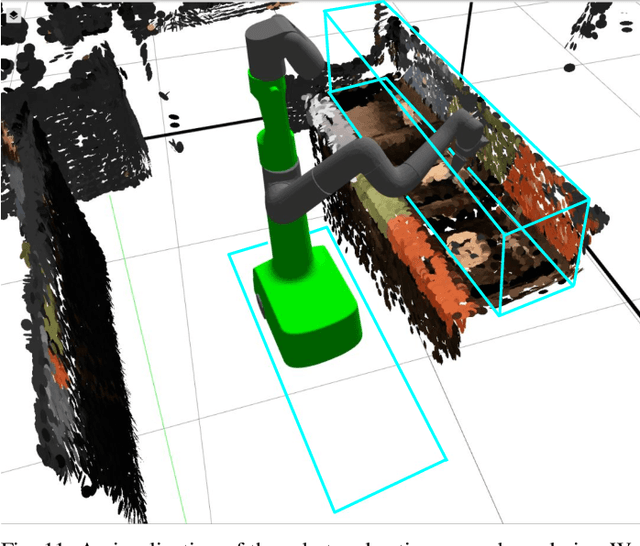
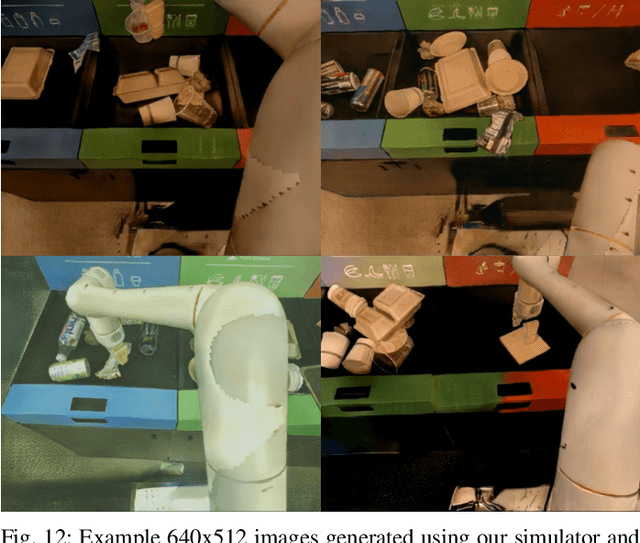
Abstract:We describe a system for deep reinforcement learning of robotic manipulation skills applied to a large-scale real-world task: sorting recyclables and trash in office buildings. Real-world deployment of deep RL policies requires not only effective training algorithms, but the ability to bootstrap real-world training and enable broad generalization. To this end, our system combines scalable deep RL from real-world data with bootstrapping from training in simulation, and incorporates auxiliary inputs from existing computer vision systems as a way to boost generalization to novel objects, while retaining the benefits of end-to-end training. We analyze the tradeoffs of different design decisions in our system, and present a large-scale empirical validation that includes training on real-world data gathered over the course of 24 months of experimentation, across a fleet of 23 robots in three office buildings, with a total training set of 9527 hours of robotic experience. Our final validation also consists of 4800 evaluation trials across 240 waste station configurations, in order to evaluate in detail the impact of the design decisions in our system, the scaling effects of including more real-world data, and the performance of the method on novel objects. The projects website and videos can be found at \href{http://rl-at-scale.github.io}{rl-at-scale.github.io}.
On Designing a Learning Robot: Improving Morphology for Enhanced Task Performance and Learning
Mar 23, 2023Abstract:As robots become more prevalent, optimizing their design for better performance and efficiency is becoming increasingly important. However, current robot design practices overlook the impact of perception and design choices on a robot's learning capabilities. To address this gap, we propose a comprehensive methodology that accounts for the interplay between the robot's perception, hardware characteristics, and task requirements. Our approach optimizes the robot's morphology holistically, leading to improved learning and task execution proficiency. To achieve this, we introduce a Morphology-AGnostIc Controller (MAGIC), which helps with the rapid assessment of different robot designs. The MAGIC policy is efficiently trained through a novel PRIvileged Single-stage learning via latent alignMent (PRISM) framework, which also encourages behaviors that are typical of robot onboard observation. Our simulation-based results demonstrate that morphologies optimized holistically improve the robot performance by 15-20% on various manipulation tasks, and require 25x less data to match human-expert made morphology performance. In summary, our work contributes to the growing trend of learning-based approaches in robotics and emphasizes the potential in designing robots that facilitate better learning.
Practical Imitation Learning in the Real World via Task Consistency Loss
Feb 03, 2022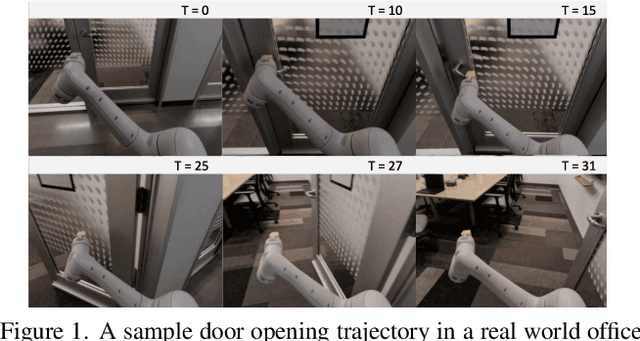

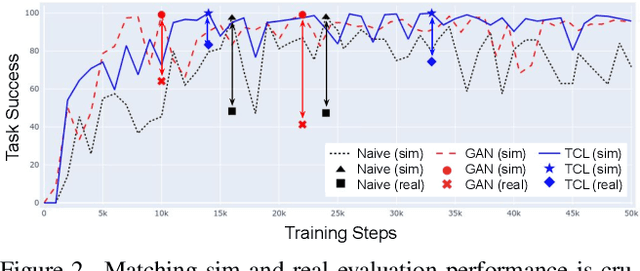
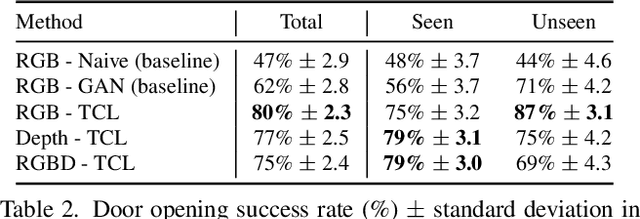
Abstract:Recent work in visual end-to-end learning for robotics has shown the promise of imitation learning across a variety of tasks. Such approaches are expensive both because they require large amounts of real world training demonstrations and because identifying the best model to deploy in the real world requires time-consuming real-world evaluations. These challenges can be mitigated by simulation: by supplementing real world data with simulated demonstrations and using simulated evaluations to identify high performing policies. However, this introduces the well-known "reality gap" problem, where simulator inaccuracies decorrelate performance in simulation from that of reality. In this paper, we build on top of prior work in GAN-based domain adaptation and introduce the notion of a Task Consistency Loss (TCL), a self-supervised loss that encourages sim and real alignment both at the feature and action-prediction levels. We demonstrate the effectiveness of our approach by teaching a mobile manipulator to autonomously approach a door, turn the handle to open the door, and enter the room. The policy performs control from RGB and depth images and generalizes to doors not encountered in training data. We achieve 80% success across ten seen and unseen scenes using only ~16.2 hours of teleoperated demonstrations in sim and real. To the best of our knowledge, this is the first work to tackle latched door opening from a purely end-to-end learning approach, where the task of navigation and manipulation are jointly modeled by a single neural network.
SimGAN: Hybrid Simulator Identification for Domain Adaptation via Adversarial Reinforcement Learning
Jan 15, 2021



Abstract:As learning-based approaches progress towards automating robot controllers design, transferring learned policies to new domains with different dynamics (e.g. sim-to-real transfer) still demands manual effort. This paper introduces SimGAN, a framework to tackle domain adaptation by identifying a hybrid physics simulator to match the simulated trajectories to the ones from the target domain, using a learned discriminative loss to address the limitations associated with manual loss design. Our hybrid simulator combines neural networks and traditional physics simulaton to balance expressiveness and generalizability, and alleviates the need for a carefully selected parameter set in System ID. Once the hybrid simulator is identified via adversarial reinforcement learning, it can be used to refine policies for the target domain, without the need to collect more data. We show that our approach outperforms multiple strong baselines on six robotic locomotion tasks for domain adaptation.
COCOI: Contact-aware Online Context Inference for Generalizable Non-planar Pushing
Nov 23, 2020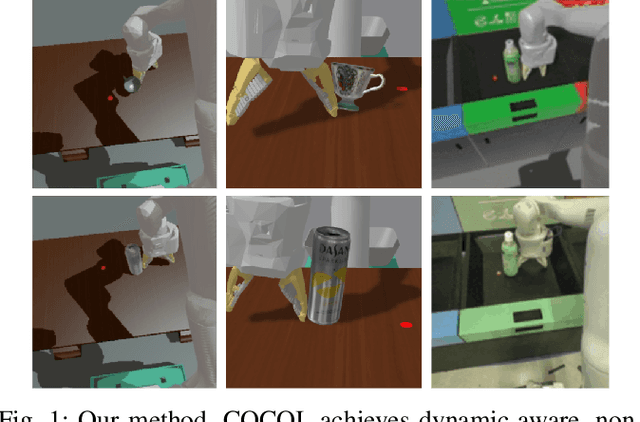
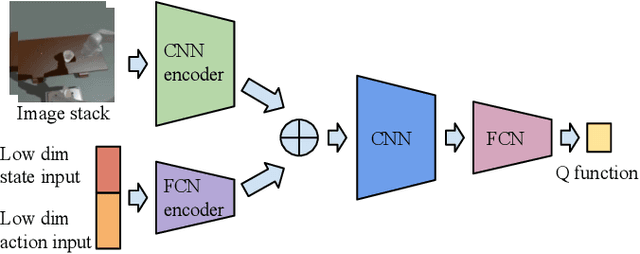
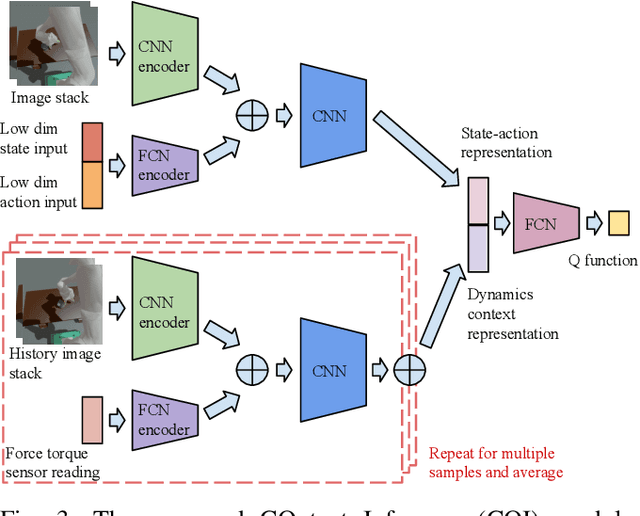
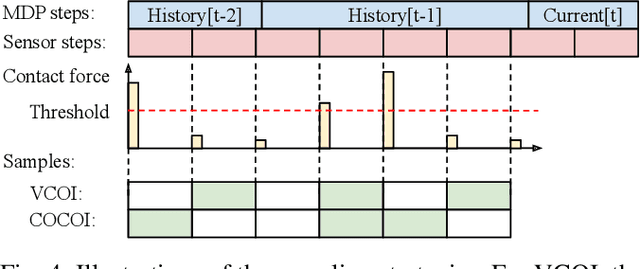
Abstract:General contact-rich manipulation problems are long-standing challenges in robotics due to the difficulty of understanding complicated contact physics. Deep reinforcement learning (RL) has shown great potential in solving robot manipulation tasks. However, existing RL policies have limited adaptability to environments with diverse dynamics properties, which is pivotal in solving many contact-rich manipulation tasks. In this work, we propose Contact-aware Online COntext Inference (COCOI), a deep RL method that encodes a context embedding of dynamics properties online using contact-rich interactions. We study this method based on a novel and challenging non-planar pushing task, where the robot uses a monocular camera image and wrist force torque sensor reading to push an object to a goal location while keeping it upright. We run extensive experiments to demonstrate the capability of COCOI in a wide range of settings and dynamics properties in simulation, and also in a sim-to-real transfer scenario on a real robot (Video: https://youtu.be/nrmJYksh1Kc)
RetinaGAN: An Object-aware Approach to Sim-to-Real Transfer
Nov 06, 2020
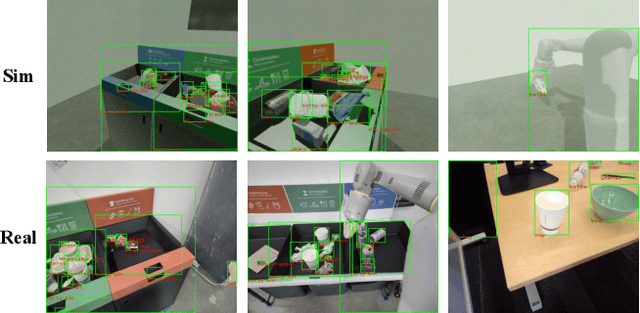
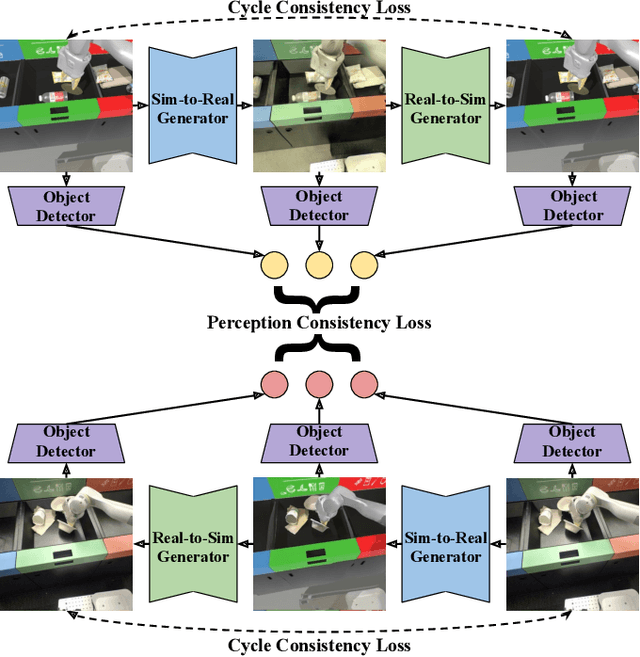

Abstract:The success of deep reinforcement learning (RL) and imitation learning (IL) in vision-based robotic manipulation typically hinges on the expense of large scale data collection. With simulation, data to train a policy can be collected efficiently at scale, but the visual gap between sim and real makes deployment in the real world difficult. We introduce RetinaGAN, a generative adversarial network (GAN) approach to adapt simulated images to realistic ones with object-detection consistency. RetinaGAN is trained in an unsupervised manner without task loss dependencies, and preserves general object structure and texture in adapted images. We evaluate our method on three real world tasks: grasping, pushing, and door opening. RetinaGAN improves upon the performance of prior sim-to-real methods for RL-based object instance grasping and continues to be effective even in the limited data regime. When applied to a pushing task in a similar visual domain, RetinaGAN demonstrates transfer with no additional real data requirements. We also show our method bridges the visual gap for a novel door opening task using imitation learning in a new visual domain. Visit the project website at https://retinagan.github.io/
Learning Fast Adaptation with Meta Strategy Optimization
Sep 28, 2019



Abstract:The ability to walk in new scenarios is a key milestone on the path toward real-world applications of legged robots. In this work, we introduce Meta Strategy Optimization, a meta-learning algorithm for training policies with latent variable inputs that can quickly adapt to new scenarios with a handful of trials in the target environment. The key idea behind MSO is to expose the same adaptation process, Strategy Optimization (SO), to both the training and testing phases. This allows MSO to effectively learn locomotion skills as well as a latent space that is suitable for fast adaptation. We evaluate our method on a real quadruped robot and demonstrate successful adaptation in various scenarios, including sim-to-real transfer, walking with a weakened motor, or climbing up a slope. Furthermore, we quantitatively analyze the generalization capability of the trained policy in simulated environments. Both real and simulated experiments show that our method outperforms previous methods in adaptation to novel tasks.
Data-Efficient Learning for Sim-to-Real Robotic Grasping using Deep Point Cloud Prediction Networks
Jun 21, 2019



Abstract:Training a deep network policy for robot manipulation is notoriously costly and time consuming as it depends on collecting a significant amount of real world data. To work well in the real world, the policy needs to see many instances of the task, including various object arrangements in the scene as well as variations in object geometry, texture, material, and environmental illumination. In this paper, we propose a method that learns to perform table-top instance grasping of a wide variety of objects while using no real world grasping data, outperforming the baseline using 2.5D shape by 10%. Our method learns 3D point cloud of object, and use that to train a domain-invariant grasping policy. We formulate the learning process as a two-step procedure: 1) Learning a domain-invariant 3D shape representation of objects from about 76K episodes in simulation and about 530 episodes in the real world, where each episode lasts less than a minute and 2) Learning a critic grasping policy in simulation only based on the 3D shape representation from step 1. Our real world data collection in step 1 is both cheaper and faster compared to existing approaches as it only requires taking multiple snapshots of the scene using a RGBD camera. Finally, the learned 3D representation is not specific to grasping, and can potentially be used in other interaction tasks.
Online Object Representations with Contrastive Learning
Jun 10, 2019



Abstract:We propose a self-supervised approach for learning representations of objects from monocular videos and demonstrate it is particularly useful in situated settings such as robotics. The main contributions of this paper are: 1) a self-supervising objective trained with contrastive learning that can discover and disentangle object attributes from video without using any labels; 2) we leverage object self-supervision for online adaptation: the longer our online model looks at objects in a video, the lower the object identification error, while the offline baseline remains with a large fixed error; 3) to explore the possibilities of a system entirely free of human supervision, we let a robot collect its own data, train on this data with our self-supervise scheme, and then show the robot can point to objects similar to the one presented in front of it, demonstrating generalization of object attributes. An interesting and perhaps surprising finding of this approach is that given a limited set of objects, object correspondences will naturally emerge when using contrastive learning without requiring explicit positive pairs. Videos illustrating online object adaptation and robotic pointing are available at: https://online-objects.github.io/.
 Add to Chrome
Add to Chrome Add to Firefox
Add to Firefox Add to Edge
Add to Edge